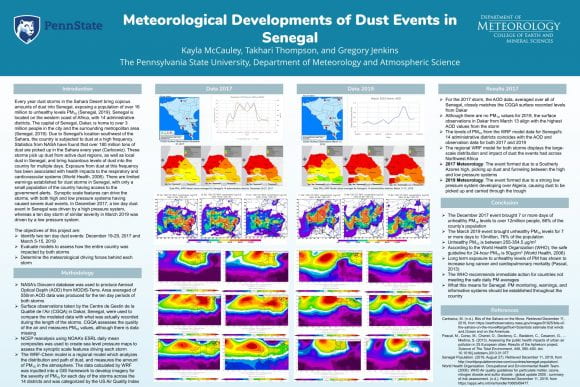IMAGE OF THE WEEK
 Takhari Thompson and Kayla McCauley (Meteorology and Atmospheric Science) won best poster in the 2020 Celebration of Undergraduate Engagement Awards for “Meteorological Developments of Dust Events in Senegal.” Additional participants included Xintong Guan and Jianfan Yang and Harman Singh. See all entries here.
Takhari Thompson and Kayla McCauley (Meteorology and Atmospheric Science) won best poster in the 2020 Celebration of Undergraduate Engagement Awards for “Meteorological Developments of Dust Events in Senegal.” Additional participants included Xintong Guan and Jianfan Yang and Harman Singh. See all entries here.
GOOD NEWS
Wendy Zeller Zigaitis was named as the recipient of the Stu Shea Endowed Scholarship from the United States Geospatial Intelligence Foundation.
Helen Greatrex joined the World Meteorological Organization WMO Societal and Economic Research Applications (SERA) Working Group and attended her first meeting in April.
Helen Greatrex was awarded a Corporate Social Responsibility grant by the global insurer and reinsurer, AXA-XL.
The Institutes of Energy and the Environment is holding a workshop on Climate and Carbon Challenges at Penn State. Wednesday, April 22, 2020, at noon. Join via zoom: https://psu.zoom.us/webinar/register/WN_ixsWkk6HRFihEVKCgjlsvA
Access session videos from the AAG virtual meeting. Were you unable to attend some of the live sessions? Most sessions were recorded and videos are now viewable in our online session gallery through May 14.
NEWS
Geography’s board representatives strengthen connections to alumni
The Department of Geography has three representatives serving on the Graduates of the Earth and Mineral Sciences (GEMS) board this year: Emily Starin Connor who earned a bachelor of science in 2012 and now works as an associate with CleanCapital; Susan Lechtanski, who earned a bachelor of science in 1997 and now works as a project manager for Penn State Auxiliary and Business Services; and Wendy Zeller Zigaitis, who earned a bachelor of science in 1999 and is currently a doctoral student.
Esri Press e-books access for students at no charge
To support distance learning during the coronavirus disease 2019 (COVID-19) crisis, Esri Press e-books are now available at no charge to students through the VitalSource Helps program until May 25, 2020.
- Students must be enrolled in a 2-year or 4-year college or university.
- Students can access to up to 7 titles of their choice.
- They must sign up with VitalSource and access e-books through Bookshelf using their school-assigned email address.
Students are being provided access now through May 25, 2020. After that, any e-books will disappear from their Bookshelf library.
RECENTLY PUBLISHED
A Comparison of Visual Attention Guiding Approaches for 360°Image-Based VR Tours
Jan Oliver Wallgrün, Mahda M. Bagher, Pejman Sajjadi, Alexander Klippel
Proceedings: 2020 IEEE Conference on Virtual Reality and 3D User Interfaces (VR)
https://conferences.computer.org/vr-tvcg/2020/pdfs/ VR2020-2f8MzUJjtCXG6Ue9RYFSN2/560800a083/560800a083.pdf
Mechanisms for guiding a user’s visual attention to a particular point of interest play a crucial role in areas such as collaborative VR and AR, cinematic VR, and automated or live guided tour experiences in xR-based education. The attention guiding mechanism serves as a communication tool that helps users find entities currently not visible in their view, referenced for instance by another user or in some accompanying audio commentary. We report on a user study in which we compared three different visual guiding mechanisms (arrow, butterfly guide, and radar) in the context of 360°image-based educational VR tour applications of real-world sites. A fourth condition with no guidance tool available was added as a baseline. We investigate the question: How do the different approaches compare in terms of target finding performance and participants’ assessments of the experiences. While all three mechanisms were perceived as improvements over the no-guidance condition and resulted in significantly improved target finding times, the arrow mechanism stands out as the most generally accepted and favored approach, whereas the other two (butterfly guide and radar) received a more polarized assessment due to their specific strengths and drawbacks.
